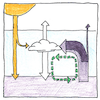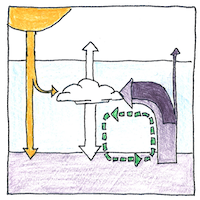John Tyndall
atmospheric sciences

|
Greenhouse effect
The gases in the air we breathe are not entirely transparent to light and heat. 1. We see our atmosphere preferentially transmits different visible wavelengths scattering some colors more than others so that in the day the sky appears blue, but at dawn or sunset, across a wider swath of gases, mainly the red light gets through. 2. Laboratory experiments show different gases absorb heat in different amounts, oxygen and nitrogen being transparent but water vapor and carbon dioxide nearly opaque 3. which means that variations of water vapor and carbon dioxide regulate Earth’s temperature like a greenhouse, letting in light but trapping a variable amount of the heat that is reflected back.
Mountaineer
“It’s hard to take air for granted at the top of the Weisshorn and easier to wonder why clouds stay in layers when you’re looking down on them from above. “Snow up here never completely melts but hot air rises so something must be happening to heat in this thinning air. “The leeward side of the mountain is dry but the windward side is green. Water vapor must condense out of the air as it’s forced to rise. “Mountaineers and balloonists know wind blows in different directions at different elevations. Barometric pressure makes this happen, or, if we reduce to first causes, sunlight and gravity. The atmosphere is stratified by gravity and heated unevenly by the sun. Wind is air moving in its layers to even out the pressure. “People ask me why a physicist climbs mountains. Even my guides won’t follow me up there. They think an educated man with a prestigious degree couldn’t learn anything important from a monstrous chunk of rock. But there it waits like the wise man in his cave impassive and taking nothing for granted.”



John Tyndall was the first person to measure the ability of gases (including nitrogen, oxygen, water vapour, carbon dioxide, ozone, and methane) to absorb heat, and was the first to prove the greenhouse effect of earth’s atmosphere. This was the beginning of the modern understanding that global warming has been caused by the activities of man.
See also in The book of science:
Readings in wikipedia: